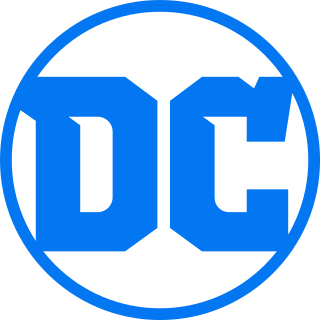
DC Comics, Inc. is an American comic book publisher and the flagship unit of DC Entertainment, a subsidiary of Warner Bros. Discovery.
Black Fury is the name of several fictional comic book characters published in the Golden Age of Comics.
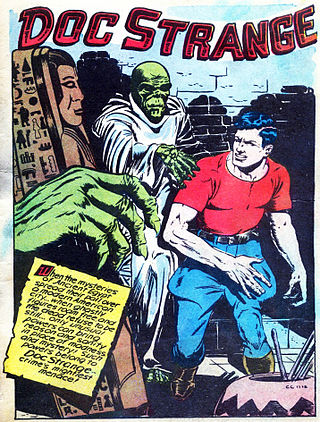
Doc Strange is a Golden Age comic book superhero who originally appeared in Thrilling Comics #1 in February 1940. The character continued in Thrilling Comics until issue #64. He also appeared in America's Best Comics #1-23 and 27.
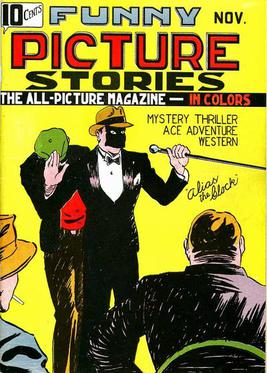
The Clock is a fictional masked crime-fighter character created in 1936, during the Golden Age of Comic Books. He was the first fully-masked hero to appear in American comic books.

National Comics Publications v. Fawcett Publications, 191 F.2d 594. was a decision by the United States Court of Appeals for the Second Circuit in a twelve-year legal battle between National Comics and the Fawcett Comics division of Fawcett Publications, concerning Fawcett's Captain Marvel character being an infringement on the copyright of National's Superman comic book character. The litigation is notable as one of the longest-running legal battles in comic book publication history.
Fox Feature Syndicate was a comic book publisher from early in the period known to fans and historians as the Golden Age of Comic Books. Founded by entrepreneur Victor S. Fox, it produced such titles as Blue Beetle, Fantastic Comics and Mystery Men Comics.
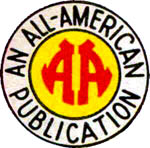
All-American Publications, Inc. was one of two American comic book companies that merged to form the modern-day DC Comics, one of the two largest publishers of comic books in the United States. Superheroes created for All-American include the original Atom, Flash, Green Lantern, Hawkman, and Wonder Woman, all in the 1940s' Golden Age of Comic Books.
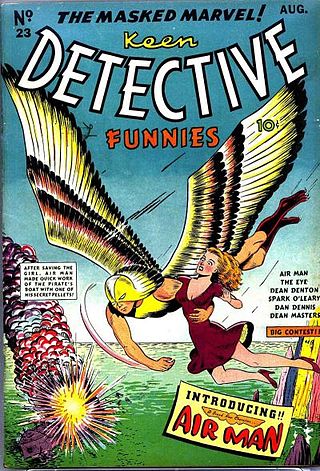
Airman is a fictional, comic-book superhero first published by Centaur Publications in 1940, during the period fans and historians call the Golden Age of Comic Books. He first appeared in Keen Detective Funnies #23, in a story by artist Harry Sahle and an unconfirmed writer, generally credited as George Kapitan. Keen Detective Funnies was cancelled after issue #24, but Centaur published two more stories in Detective Eye Comics #1 and 2 before pulling the plug on the character.
The Fantom of the Fair is one of the earliest published Golden Age superheroes. He debuted in Centaur Publications' Amazing Mystery Funnies vol. 2, #7, the overall 11th issue of that title. He premiered, according to cover dates, the same month as DC Comics' Sandman, Fox Publications' The Flame, and Centaur's Masked Marvel. He was created by Paul Gustavson, who had previously created the Arrow for Centaur.

The Skyman is a fictional comic book superhero that appeared stories during the Golden Age of Comic Books. Created by writer Gardner Fox and artist Ogden Whitney, the character first appeared in the Columbia Comics omnibus title Big Shot Comics #1. He is unrelated to the DC Comics character.
The Green Mask is the name of two comic book superheroes, both published by Fox Feature Syndicate. Both are in the public domain with some of the original stories having been reprinted by AC Comics.

The Bouncer is a fictional superhero who appeared in comic books published by Fox Feature Syndicate. The Bouncer had no secret identity, but was in reality a statue of the Greek mythological figure Antaeus. The statue had been sculpted by Adam Anteas, Jr., a descendant of the very same legendary figure. Like his Greek ancestor, Anteas Jr. gained power when in contact with the earth. Anteas Jr.'s power was that he bounced back whenever he struck the ground; the harder he hit, the higher he bounced. Like his ancestor, he lost his power when out of contact with the ground.

Samson is a superhero who appeared in comic books published by Fox Feature Syndicate. He first appeared in Fantastic Comics #1. The writer was uncredited, but is believed to be Will Eisner; the artist was Alex Blum, using the pseudonym "Alex Boon".
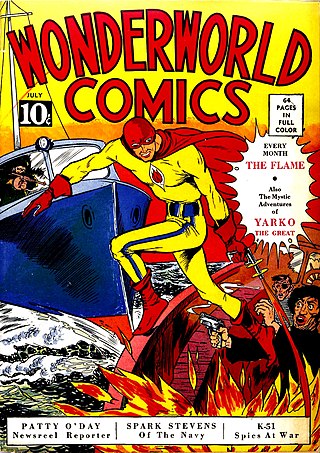
The Flame is a superhero that appeared in American comic books published by Fox Feature Syndicate. The Flame first appeared in Wonderworld Comics #3 and was created by writer Will Eisner and artist Lou Fine. The Flame became Wonderworld's primary character.

The Masked Marvel is a fictional superhero originally published by Centaur Publications. He debuted in July 1939, on the pages of Keen Detective Funnies #7. The character continued to appear as the feature in Keen Detective Funnies until the 24th issue, as well as in his own title, which lasted three issues.

Shock Gibson is a fictional comic book superhero who first appeared in Speed Comics #1, from Brookwood Publications. He was created by artist Maurice Scott, who drew it through issue #11, and an unknown writer. His 1939 introduction makes him one of comic books' earliest superheroes. He also appeared in All-New Comics #8.

Pyroman is a fictional superhero that appeared in comic books published by Nedor Comics. His first appearance was in Startling Comics #18, with art by Jack Binder. This character was later revived by both AC Comics and America's Best Comics.
The Moth is the name of two American comic-book superhero characters. The first was created by artist Jim Mooney and an unknown writer for Fox Feature Syndicate in 1940, during the period fans and historians call the Golden Age of Comic Books. The second was created by writer-artist Steve Rude in 1998 for Dark Horse Comics.
Captain Courageous is a fictional superhero character who first appeared in Banner Comics #3 from Ace Comics.
Supersnipe is a fictional character who appeared in a series of comic books published by Street & Smith from 1942 to 1949. Supersnipe was the imagined alter ego of Koppy McFad, "the boy with the most comic books in the world." He was created by writer-artist George Marcoux, who had previously assisted Percy Crosby on the comic strip Skippy.













